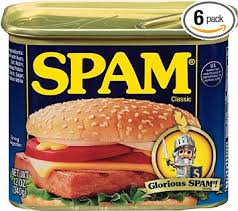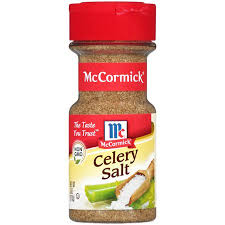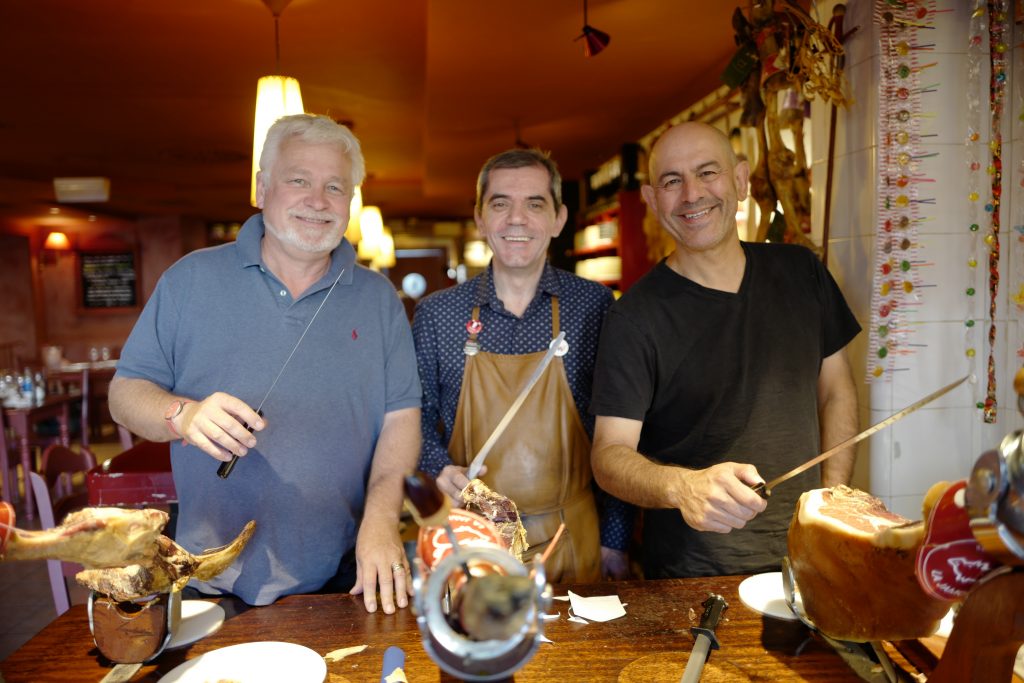
Full transcript of this podcast at the bottom of this page. This is just the fun and science stuff.
Whenever mom would have “spam and eggs” for breakfast, it was a favorite. Growing up in Alaska in the 1960’s Spam was not only a favorite breakfast item, but I loved having a Spam sandwich in my lunchbox.
My friend, Simon Majumdar was in Producergirl production studios doing his podcast about the history of food (Eat My Globe) when I stopped by and we had a chat about Spam.
I still think it is delicious, but with the concerns over sodium nitrites in processed meats, it is probably not something I will be buying for my family as much as I had it growing up. I
Nitrites are thought to be the ingredient that cause processed meats to have an increased risk of colorectal cancer. But, there is a great deal of reason to be skeptical about that. See more below.
Simon points out that even the Romans used nitrites in processing their food- they used “saltpeter” which is Potassium Nitrite. Nitrites, and nitrates, are important to preservation of meat. When it comes to what will cause you death sooner – bacteria win here. So, if you have a choice between processed meats with nitrites or death by botulism – well, I can always get a colonoscopy.
But processed meats are an issue because so many people today think bacon is the answer to weight loss. It isn’t.
The latest 1-page report is a summary by the World Health Organization to classify red meat and processed meats has created a storm of news with headlines like “bacon as bad as cigarettes.” (It isn’t, by the way, it isn’t anywhere near as bad as cigarettes.)
If you are 50 years old and eat 2 slices of bacon (about 50 grams) per day then your risk of developing colorectal cancer increases from 0.68 per cent to 0.8 per cent in the next ten years. Or, another way of looking at it – most people have a 5% risk of getting colon cancer in their lifetimes, and by eating the bacon you increase it to 6%. Would you change your habits to reduce cancer risk by 1 per cent (this is where vegetarians feel smug – although some wrongly believe their vegetables make them exempt from cancer).
This is not new information; this has been in the public sphere for years. But it is complicated (like most relationships).
With processed meat there has been a small, but consistent, correlation between colorectal cancer and consumption. This isn’t surprising. The smoke used to cure the meat is not healthy, nor is the excess salt, and then there are the nitrates/nitrites. Not all processing comes from caustic materials – salt cured meat is given the same classification as smoked meats, or meats cured in nitrates. The studies have never made that distinction.
The studies that showed the cancer correlation were from large population studies, where the incidence of colon cancer was increased among those who ate processed meat.
You will read how some will state that the evidence in these studies is weak. That there is many other factors that can be responsible for this increase besides bacon. For example, some red meat eaters have a higher consumption of alcohol, which is a promoter of cancer. Then there is the increased level of fat in the meat, and increased fat causes severe gut inflammation (sorry Paleo friends). Or, that many of these studies are based on dietary recall – which is flawed from the outset.
The association with processed meats and cancer isn’t zero or negative. The association is real, it has been seen in multiple studies, and reported in multiple observational studies. My favorite- the incidence of cancer in cows who ate nitrite preserve herring – of course, that study was from Norway (who else would feed cows herring).

Herring fed cow – says moo with an accent
This was a part of the more than 800 studies that were examined by the WHO. What cannot be denied is that the risk is moderated by many other factors (maybe diet, maybe your gut bacteria, maybe your own genes).
What is the MECHANISM of cancer and bacon?
We don’t know. In spite of speculation about how meat is cooked, how it is kept, how it is processed, there is not a single mechanism or a model for how cancer is caused by processing meat.
But a model is not necessary. There is not a model for lung cancer and cigarettes in animals. On the other hand the evidence – the statistical data for smoking and lung cancer is so high that one is not needed.
Perspective: relative risk of smoking and lung cancer is 20, relative risk of eating two slices of bacon daily and colon cancer is 1.2 – a relative risk of 1 means there is no correlation.
To cause cancer, we have to change the DNA. The classic model of cancer is from radiation that causes cancer by mutation of the DNA. We have a cause, a method, and we can reproduce it. We can irradiate bacteria and see them change their DNA, or parts of mice. We see radiation damage to skin cells (from the sun) and people who live near radiation sources have high risks of developing cancer.
Proposed Mechanisms for cancer and bacon or other processed meats
The proposed mechanism for developing cancer from red and processed meats comes down to damage to the gut. One group of compounds the N-nitroso group (NOC’s) damage the lining of the gut – and there are more NOCs in processed meats, which form these at a high rate. This comes from the sodium nitrates and nitrites used to preserve the meats. The concern is that a portion of these compounds become changed in the gut by bacteria and they change into nitrosoamines, which can cause cancer in things, like cows.
 Some “Nitrate Free” processed foods are tricky because they use celery powder. Celery powder you say? Yes, turns out that has a high concentration of nitrates. And so when processed meats put this in they are really just fooling you.
Some “Nitrate Free” processed foods are tricky because they use celery powder. Celery powder you say? Yes, turns out that has a high concentration of nitrates. And so when processed meats put this in they are really just fooling you.
Nitrates and nitrites
They are chemically two distinct compounds . It is easy to mix them up, but when they hit the gut it is what happens to them that is important. If you have the right conditions then bacteria will convert them to the nitrosamines, which are a problem. But not all guts do that.
On the other hand- most of the compound is converted to nitric oxide which our body uses to help regulate blood pressure, heart function, and etc. Suffice to say- this is something that is terribly important to our body.
But why are not all nitrates/nitrites not converted to nitrosamines? A part has to do with the pH of the stomach – the more acidic the more are converted to the helpful nitric oxide. Perhaps another reason that people who use PPI or those who have inability to produce acid in their stomach have a higher incidence of cancer.
Adding ascorbic acid (vitamin C) has also been shown to decrease nitrosamine function, and ascorbic acid is another preservative for food.
Vegetables and Nitrites
Yes, over 90% of the nitrites in your body come from vegetables and only 10 per cent come from processed meats. So why are nitrites an issue in Spam? Well, clearly god(s) are vegetarian.
My 94 yo dad still thinks vegetables are evil, except potatoes of course. And who can argue with a 94 yo about longevity?
There is a toxic level of everything- and there must be with vegetables.
Blue Baby Syndrome
This is just a fun fact, nothing to do with culinary medicine, but related. Infants have lower acid levels in their stomachs than older children or adults. Because their stomach is more alkaline the stomach juices facilitate conversion of nitrates to nitrite leading to nitrite toxicity and actual anemia. These kids actually turn a pale blue color because the nitrite levels alter the hemoglobin in the blood to what we call methemoglobinemia. I remember, as a medical student, being on the pediatric service and seeing this blue kid, which is formally known as “blue baby syndrome.” Normal skin is slightly pink from the hemoglobin, but with methemoglobin the moleculre is more blue. It does lead to problems with inability to transport oxygen so the children need supplemental oxygen, but most of the reason you see this is babies that are less than a year old who are fed a lot of vegetables with nitrites: beets, cabbage, carrots, celery, radishes and spinach. Some infants can also get this because of well water that has high levels of nitrates.
Suffice to say, if your infant is blue- see your pediatrician ASAP.
The other is the mechanism by which the meat is heated. That lovely char on meat called the Maillard Reaction produces heterocyclic amines (HCAs) that are associated with cancer. Ironically, all meats (the white meat such as poultry, or fish) can have these – but red meat produces higher levels of HCAs. The “blackened” rubs while producing flavor do not cause the same levels of HCAs.
The problem with increased HCAs from grilled meat can be prevented – speaking of Culinary Medicine – by using marinades – and you thought marinades were just for flavor!
Advice:
Be moderate in all you eat. Get a screening colonoscopy starting at age 45, if you have no history of cancer (younger if you have spent many years eating processed meats).
 That brings us to the famous Iberico hams of Spain. These pigs are grown in lots of acres, feasting on hazelnuts, and cured only with salt. There are some naturally occurring nitrates/nitrites in those salts, but far lower than the level found in Spam. But we will save these amazing products for another podcast. Until then – see how @producergirl just hams it up?
That brings us to the famous Iberico hams of Spain. These pigs are grown in lots of acres, feasting on hazelnuts, and cured only with salt. There are some naturally occurring nitrates/nitrites in those salts, but far lower than the level found in Spam. But we will save these amazing products for another podcast. Until then – see how @producergirl just hams it up?
Transcript
Terry Simpson: Hey, all you geniuses. Today we’re going to have a little fun. You get to listen to my good friend, Simon Majumdar, and I talk about Spam: Not the email, but the original canned meat, something I grew up eating as a kid in Ketchikan, Alaska. Simon has a new podcast called Eat My Globe, and he has an entire episode devoted to the history of Spam. Listen in. I hope you enjoy it.
Terry Simpson: My name is Dr. Terry Simpson and this is my podcast, Culinary Medicine: Food Cons and Food Conversations, where we have conversation about food as medicine and discuss food cons, exposing myths, cons, and mountebanks.
Terry Simpson: Simon and I have been friends for about five years. When we get together, usually over a glass of wine, we then to, well, go off, so much so, that my wife wants to produce a podcast called Two Old Men and a Martini. Well, I don’t know what old men she’ll get besides Simon. Anyway, have a listen. Oh, and there is some culinary medicine here.
Terry Simpson: Speaking of processed foods, processed meats-
Simon Majumdar: Yes.
Terry Simpson: I grew up in Alaska, and as you probably know, the two heaviest consumptions of one of your podcasts, one of em’s [Why 00:01:36] and the second one is Alaska. So, guess what meat I had three or four times a week.
Simon Majumdar: Well, you did, but actually, you’d be surprised. Alaska comes way down the list.
Terry Simpson: Among the states in the United States, Alaska is the second largest consumer of canned Spam. Why do I know this? Well, it’s from the science of Spamology.
Terry Simpson: Oh, we stopped ordering it?
Simon Majumdar: Well, no, you still do. I did a podcast on the history of Spam, which actually has a-
Terry Simpson: Not the email?
Simon Majumdar: No, not … although, the two are related because of the Monty Python sketch. That’s where the term for the junk email comes from, and everyone knows that sketch where they start talking about eating spam, but the reason I wanted to do it, because the history of Spam goes much further back than the product itself, because it goes back to Napoleon, Napoleonic times where they invented canning. It goes through even further back to Roman time.
Terry Simpson: 10,000 francs for that can.
Simon Majumdar: 12,000.
Terry Simpson: 12,000 francs.
Simon Majumdar: 12,000, and a guy called Nicolas Appert and you know what his other claim to fame was? He invented the bouillon cube, so there you go. But, if you go back to Roman times when they were preserving meats and hams, and the way they talk about it in, I think it’s the Odyssey, they talk about preserving hams identical to the way that they do it now around the world, so just, a lot of similarity, but anyway, with Spam, no, the three countries: number three is the Philippines, and a lot of it’s to do with the second World War, quite frankly. That’s where soldiers were. So, number three is the Philippines.
Simon Majumdar: Number two is Hawaii, and number one is Guam, where they eat … and listen to this. You’re a doctor so you can tell me about it but. They eat 16 cans a year per person. They have McDonald’s franchises. I think there’s five of them on Guam, and they serve the equivalent of 57,000 cans of Spam a year.
Terry Simpson: And you know, when you go to Hawaii … tourists don’t do this. Tourists will not stop in the local 7/11 or corner convenience store, but you go in there and they have the equivalent of Spam sushi.
Simon Majumdar: Spam musubi, it’s called.
Terry Simpson: It is delicious.
Simon Majumdar: I really like it a great deal, and if you go to Korea, which again got to love Spam because of American soldiers there during the Korean War-
Terry Simpson: They were starving. All those places were starving. American soldiers had meat they didn’t know, and so they fell in love with this.
Simon Majumdar: Well, because it lasted. Because they were waiting for fresh food to turn up, they ate these rations. Spam has been so much a part of warfare, in fact, during since it was first, I think, trademarked in 1937, 150 million cans of Spam were purchased by the American government during the second World War, and even Khrushchev, the leader of the Soviet Union said that they would not have been able to feed their armies without the Spam that they were sent by the American government.
Terry Simpson: See, and they don’t … how much … do they still sell it to the military?
Simon Majumdar: Oh, yeah. The military still has Spam.
Terry Simpson: ‘Cause I don’t know about you, but I’ve tried some recent military rations. Yeah, that’s kind of … I’d rather open a can of Spam.
Simon Majumdar: Well, the thing is that I did some cooking with Spam when I was doing the podcast, and I actually rather liked it.
Terry Simpson: I did, too.
Simon Majumdar: I thought … but you use it sparingly, the traditional Spam, ’cause there is a higher salt content. I think it’s … and you would probably know more than me. It’s about 790 mg, so I think that’s about a third of the daily amount of salt.
Terry Simpson: Right, so there’s only six ingredients in Spam, and one of ’em is salt, and one of ’em is the one that I have a problem with, which are nitrites.
Simon Majumdar: Which a lot of people, though, have been using for curing going back to the Roman times, so it’s the Romans who first discovered that pink salt or saltpeter or whatever you want to call it, and they find out that it gave their cured meats a nice pink color.
Simon Majumdar: So, I still use some of that if I make bacon because I find if I don’t, it’s rather gray and people go, “Ooh, there’s something wrong with it.” They think there’s something wrong with it.
Terry Simpson: Sodium chloride is one ingredient in Spam. You know it as table salt. Sodium nitrite is another ingredient in Spam, and nitrites are the issue. Sodium nitrites are linked to colon and rectal cancer, which is why the current recommendations are for people to reduce nitrites in their diet, specifically, processed meats. If you shop for bacon, hot dogs, or other processed meats, buy the nitrite-free ones.
Terry Simpson: The interesting thing is that when we … you know, there’s a pretty good association between increased, what we call, preserved meats that have nitrites in them, and cancers. One of the things that I found interesting was, when we were in Spain, literally on every street corner, there is a Jamónery, a place that sells ham.
Simon Majumdar: Ham, absolutely, and all kinds of cured meats.
Terry Simpson: Right, and they don’t use nitrites in their curing process.
Simon Majumdar: No, they just use salt, but there’s a particular salt that I think has … and you can confirm this or not, but it has a certain element of nitrate in it, so it’s not a chemical that’s added. It’s actually just part of the salt process that they’re using, and it may be just the natural salts in the air that they have there when they’re making these hams, ’cause they’ve been making them in the same way for 1,000 years.
Simon Majumdar: I think it’s, again, like all things: if you were to sit and eat two pounds of bacon with nitrite in it a day, you’re probably not gonna do yourself much good.
Terry Simpson: There are no nitrates in the ibérico hams of Spain. They are simply cured with salt. Sadly, because of import laws, they are difficult if not impossible to get in the states. Sodium nitrite and sodium chloride are two different chemicals. Both have sodium, but the nitrites are used in many US products for preservatives. The recent data showing the increased risks of colon and rectal cancer with nitrites has made an impact, because now you can buy many processed meats without nitrites.
Simon Majumdar: I probably actually don’t eat that much bacon. I might eat it … once every month or so, I might add bacon to a dish, but I’m only going to include a couple of ratios. I’m thinking, then, the risk is relatively low.
Terry Simpson: No, that risk is … I mean, it’s like anything that’s toxic, if you don’t overwhelm your system, it can handle most things, but I think the things that was fascinating to me is, they would bring out this plate of ham, thinly sliced, so thinly sliced that you could actually use it for reading glasses.
Simon Majumdar: The key with slicing Spanish ham is you’re supposed to be able to read the name of the knife maker through the ham.
Terry Simpson: And, what was fascinating was: so, we got this plate of ham, and I probably didn’t even have an ounce of it, and I was stuffed.
Terry Simpson: So, that was the two of us, just with a glass of wine. If you liked it, we might record a few more in some lonesome bar that makes great martinis and has a mediocre bottled wine.
Terry Simpson: Canned Spam is delicious, but, one of the key ingredients of Spam is sodium nitrite, and that is concerning. Most people believe that the reason processed meats are associated with a higher risk of cancer is the sodium nitrite, which is used as a preservative. Those are the same ingredients found in bacon, salami and a lot of processed meats that you may buy. So, our recommendation is buy the nitrite-free processed meats if you can. Sadly, Spam does not come nitrite free.
Terry Simpson: Most of the time, a person’s body can handle a little bit of toxin, but it’s always best to avoid it. But, much as the people from Guam have a high rate of cancer and a shorter lifespan, it’s their lifestyle and their diet, so think about eating food that is better for you, and if you get a chance to get one of those hams from Spain, you will be in for a treat.
Terry Simpson: All right, let me know if you want further episodes of Two Men and a Martini. Special thanks to Simon Majumdar for lending his comments to today’s show, and of course, thanks to you for listening to this episode of Culinary Medicine with me, Dr. Terry Simpson. This will be our final episode for this season. Season two will be coming up in another month or so. While I am a doctor, I am not your doctor, and you should always seek the advice of a trusted, licensed medical provider with experience in your particular condition or concern before taking any action.
Terry Simpson: But, if I am your doctor, what are you cooking tonight? I might have some Spam. Culinary Medicine is a part of the Your Doctor’s Orders Network, and is produced and distributed by our friends at Simpler Media. Evo Terra is my creative genius who adds the music and makes this whole process work. My executive producer is a talented and beautiful producer girl from Producer Girl Productions, and you can follow me on Twitter where I’m @drterrysimpson. That’s DR Terry Simpson. Until next time, don’t drink the water; drink the wine, unless you’re with Simon. Then, have a martini.
